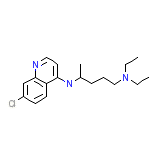Chloroquine




Categoria
Chloroquine Nombres de marca, Chloroquine Analogos
- 3377 RP opalate
- Amokin
- Aralen
- Aralen HCl
- Arechin
- Arthrochin
- Artrichin
- Avlochlor
- Avloclor
- Bemaco
- Bemaphate
- Bemasulph
- Benaquin
- Bipiquin
- Capquin
- Chemochin
- Chingamin
- Chloraquine
- Chlorochin
- Chlorochine
- Chloroquina
- Chloroquine (VAN)
- Chloroquine Phosphate
- Chloroquinium
- Chlorquin
- Cidanchin
- Clorochina
- Cocartrit
- Delagil
- Dichinalex
- Elestol
- Gontochin
- Heliopar
- Hydroxychloroquine Sulfate
- Imagon
- Iroquine
- Klorokin
- Lapaquin
- Malaquin
- Malaren
- Malarex
- Mesylith
- Neochin
- Nivachine
- Nivaquine
- Nivaquine B
- Nivaquine [as sulfate]
- Pfizerquine
- Plaquenil
- Quinachlor
- Quinagamin
- Quinagamine
- Quinercyl
- Quingamine
- Quinilon
- Quinoscan
- Resochen
- Resochin
- Resoquina
- Resoquine
- Reumachlor
- Reumaquin
- Roquine
- Sanoquin
- Silbesan
- Siragan
- Solprina
- Sopaquin
- Tanakan
- Tresochin
- Trochin
Chloroquine Marca los nombres de mezcla
Chloroquine Formula quimica
C18H26ClN3
Chloroquine RX enlace
http://www.rxlist.com/cgi/generic2/hquine2.htm
Chloroquine FDA hoja
Chloroquine MSDS (hoja de seguridad de materiales)
Chloroquine Sintesis de referencia
No hay información disponible
Chloroquine Peso molecular
319.872 g/mol
Chloroquine Punto de fusion
289 oC
Chloroquine H2O Solubilidad
10.6 mg / L
Chloroquine Estado
Solid
Chloroquine LogP
4.474
Chloroquine Formas de dosificacion
Tableta
Chloroquine Indicacion
Para el tratamiento de supresión y para los ataques agudos de malaria por P. vivax, P. malariae, P. ovale y cepas susceptibles de P. falciparum, el agente de segunda línea en el tratamiento de la artritis reumatoide
Chloroquine Farmacologia
La cloroquina es el medicamento prototipo contra la malaria, más ampliamente utilizados para tratar todos los tipos de malaria a excepción de la enfermedad causada por Plasmodium falciparum resistente a la cloroquina. Es muy eficaz contra formas eritrocíticas del Plasmodium vivax, Plasmodium ovale y Plasmodium malariae, las cepas sensibles de Plasmodium falciparum y gametocitos de Plasmodium vivax. Ser alcalina, la droga llega a la alta concentración dentro de las vacuolas de alimentos del parásito y eleva el pH. Se encuentra a inducir una rápida agregación del pigmento. Cloroquina inhibe la enzima polimerasa hemo parásito que convierte la hemo tóxicos en no es tóxico hemazoin, lo que resulta en la acumulación de hemo tóxicos dentro del parásito. También puede interferir con la biosíntesis de los ácidos nucleicos.
Chloroquine Absorcion
Completamente absorbido desde el tracto gastrointestinal
Chloroquine Toxicidad
No hay información disponible
Chloroquine Informacion de Pacientes
PATIENT INFORMATION
Complete blood cell counts should be made periodically if patients are given prolonged therapy. If any severe blood disorder appears which is not attributable to the disease under treatment, discontinuance of the drug should be considered. The drug should be administered with caution to patients having G-6-PD (glucose-6 phosphate dehydrogenase) deficiency.
In patients with preexisting auditory damage, chloroquine should be administered with caution. In case of any defects in hearing, chloroquine should be immediately discontinued, and the patient closely observed.
Since this drug is known to concentrate in the liver, it should be used with caution in patients with hepatic disease or alcoholism or in conjunction with known hepatotoxic drugs.
Patients with history of epilepsy should be advised about the risk of chloroquine provoking seizures.
Because of the potential for serious adverse reactions in nursing infants from chloroquine, a decision should be made whether to discontinue nursing or to discontinue the drug, taking into account the potential clinical benefit of the drug to the mother.
Irreversible retinal damage has been observed in some patients who had received long-term or high-dosage 4-aminoquinoline therapy. Retinopathy has been reported to be dose related.
Follow Rxlist link and drugs.com link for detailed patient information.
Complete blood cell counts should be made periodically if patients are given prolonged therapy. If any severe blood disorder appears which is not attributable to the disease under treatment, discontinuance of the drug should be considered. The drug should be administered with caution to patients having G-6-PD (glucose-6 phosphate dehydrogenase) deficiency.
In patients with preexisting auditory damage, chloroquine should be administered with caution. In case of any defects in hearing, chloroquine should be immediately discontinued, and the patient closely observed.
Since this drug is known to concentrate in the liver, it should be used with caution in patients with hepatic disease or alcoholism or in conjunction with known hepatotoxic drugs.
Patients with history of epilepsy should be advised about the risk of chloroquine provoking seizures.
Because of the potential for serious adverse reactions in nursing infants from chloroquine, a decision should be made whether to discontinue nursing or to discontinue the drug, taking into account the potential clinical benefit of the drug to the mother.
Irreversible retinal damage has been observed in some patients who had received long-term or high-dosage 4-aminoquinoline therapy. Retinopathy has been reported to be dose related.
Follow Rxlist link and drugs.com link for detailed patient information.
Chloroquine Organismos afectados
Plasmodium














